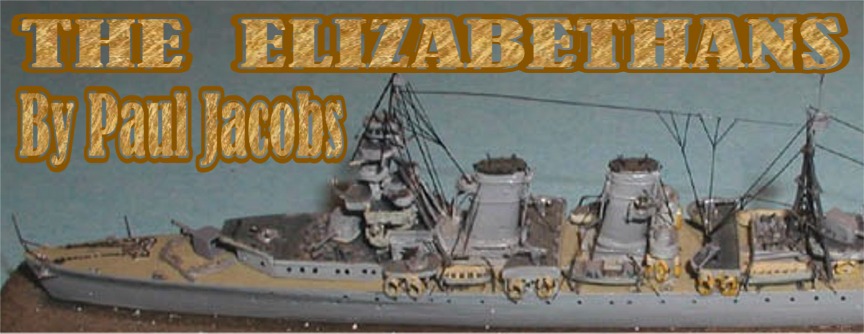 |
 |
At the end of World War I, the British built a class of cruisers different from anything that had come before or would follow afterwards. These ships, known variously as "The Elizabethans," or the "Hawkins" Class were a development of the prior "Town" Class light cruisers, but larger and more heavily armed. Most of them would have long careers, and would undergo numerous and interesting modifications, making them interesting subjects for models. The genesis of the design was the need, early in the war, for fast heavily armed cruisers to hunt down and destroy German raiders. Because the German ships were expected to mount 5.9 inch guns, a heavier gun than the 6 inch, then in use on the latest British light cruisers was desired. Thus the ships were armed with seven 7.5 inch guns, a weapon in use on some of the British armoured cruisers, and the largest gun that could be loaded by hand . Five ships, displacing nearly 10,000 tons each were built, Hawkins, Cavendish, Raleigh, Frobisher and Effingham. The first two were commissioned before the Armistice, while the last two did not commission until the mid-1920's.
Cavendish was renamed Vindictive before commissioning and was completed as an aircraft carrier rather than a cruiser. However, in the early 1920s the ship was reconverted to a cruiser, retaining however, a catapult and hanger in place of B mount. In the 1930's she was then modified to an unarmed training ship, and finally to a repair ship, in which capacity she served throughout World War II. The existence of these ships played a seminal role in the negotiations over the Washington Naval Limitations Treaty of 1921. Determined to preserve these ships, the British pushed for limits on the size of individual new cruiser construction to be no less than 10,000 tons, with guns of at least 7.5 inches but not greater. In the end, the conference settled on 10,000 tons and 8 inch guns, which would in the ensuing two decades produce the typical Treaty cruisers, Tinclads, or heavy cruisers, as they eventually were called. Every major navy, (and some minor ones), came to possess such ships.
The Raleigh had a very short life, running aground off Labrador in 1922, becoming a total loss. In 1927, Frobisher had a catapult and crane fitted, items that were eventually removed. Under the terms of the London Naval Treaty of 1932, all three ships were required to be disarmed. Frobisher became a cadet’s training ship, losing two of her 7.5 inch guns and a number of 4 inch guns. Hawkins and Effingham were both disarmed and placed in reserve in 1937-38, but soon thereafter the London Treaty lapsed and it was proposed to convert the two ships to 6 inch gun cruisers. This was accomplished with Effingham, and she emerged in 1938 with a markedly different appearance from any other cruiser in the Royal Navy. The two models of Effingham shown here differ in regards to their secondary armament. Originally completed with single 4 inch guns, as shown in the Argonaut model, the ship was rearmed in 1939 with twin 4 inch mounts as shown on the Neptun model. Because of the approaching war, Hawkins was merely refitted with her former armament, and was not rebuilt. Frobisher was also reconverted, although she did not receive priority, and thus the work was not started until January 1940, and completed only in March 1942. Upon completion the ship mounted only five 7.5 inch guns, rather than seven.
All three ships had very active careers before and during the war, although Effingham’s service was cut short when she sank in 1940 during the Norwegian Campaign, after striking an undersea rock. Frobisher and Hawkins both served during the war with the Eastern Fleet, then were present on D-Day for the Normandy invasion. They were both scrapped after the end of the war.
Models of these ships in 1:1200 and 1250 scales have been made ever since the 1920s by Bassett-Lowke, Wiking, Tremo, Comet, Framburg, Superior, Neptun and Argonaut. The models shown here were made by Neptun and Argonaut, as well as two of the Vindictive by Anker, one of Frobisher, by Eneris, and one, a wooden and plastic model of Frobisher handmade by an unknown craftsman. It is interesting to compare these Frobisher models with the Neptun model.